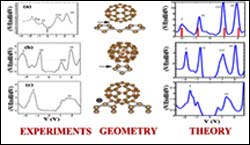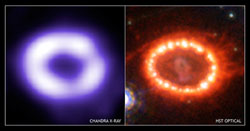This area deals with the fundamental laws and building blocks of nature and how they interact, the properties and the behavior of matter, and research into space and time and their structures.
innovations-report provides in-depth reports and articles on subjects such as astrophysics, laser technologies, nuclear, quantum, particle and solid-state physics, nanotechnologies, planetary research and findings (Mars, Venus) and developments related to the Hubble Telescope.

Engineers at Purdue University have created a nanotech simulation tool that shows how current flows between silicon atoms and individual molecules to help researchers design “molecular electronic” devices for future computers and advanced sensors.
Molecular electronics could make it possible to manufacture hardware by “growing” circuits and devices in layers that may “self-assemble,” similar to the growth of structures in living organisms. Devices for a variety of applicati

Data from the NASA/ESA/ASI Cassini spacecraft indicate that Saturn’s majestic ring system has its own atmosphere – separate from that of the planet itself.
During its close fly-bys of the ring system, instruments on Cassini have been able to determine that the environment around the rings is like an atmosphere, composed principally of molecular oxygen. This atmosphere is very similar to that of Jupiter’s moons Europa and Ganymede.
The finding was made by two

Recent Chandra observations have revealed new details about the fiery ring surrounding the stellar explosion that produced Supernova 1987A. The data give insight into the behavior of the doomed star in the years before it exploded, and indicate that the predicted spectacular brightening of the circumstellar ring has begun.
The supernova occurred in the Large Magellanic Cloud, a galaxy only 160,000 light years from Earth. The outburst was visible to the naked eye, and is the bright

Working at the Armagh Observatory with Dr Simon Jeffery and Dr Tolis Christou, Nuffield Science Bursary scholar Elizabeth Connolly was using an internet connection to control the Faulkes Telescope in Hawaii. During her half-hour observing session, she briefly turned the telescope to where the new planet had been discovered. After taking a photograph with the 2-metre telescope, she compared the new image with an old image of the same patch of sky. The new planet was clearly visible as a faint s

With the help of NASA’s Spitzer Space Telescope, astronomers have conducted the most comprehensive structural analysis of our galaxy and have found tantalizing new evidence that the Milky Way is much different from your ordinary spiral galaxy.
The survey using the orbiting infrared telescope provides the fine details of a long central bar feature that distinguishes the Milky Way from more pedestrian spiral galaxies.
“This is the best evidence ever for this long

Scientists at CERN announced the completion of the target assembly for the CERN neutrinos to Gran Sasso project, CNGS. On schedule for start-up in May 2006, CNGS will send a beam of neutrinos through the Earth to the Gran Sasso laboratory 730km away in Italy in a bid to unravel the mysteries of nature’s most elusive particles.
CNGS forms a unique element in the global effort to understand neutrinos, the chameleons of the fundamental particle world. Neutrinos come in three types, or flavou